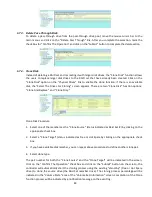
88
o
“Blank Disk Only”-it will trigger the rebuilding if and only if the inserted disk has not been in
the RAID array before, which has no RAID signature on it. So when a previously removed
disk is self re-inserted, it won’t trigger the degraded RAID array to rebuild, and so that the
administrator has a chance to identify this mis-behaving disk and replaces it.
o
“Always” – it is what it was before. Whenever a disk is inserted/re-inserted whether new or
previously existed, it always trigger a rebuilding for the Degraded RAID set/Volume.
o
“Disable” – it will not trigger rebuilding regardless what sort of disk plugging in. When
“Disable” and/or “Blank Disk Only” is selected, the re-inserted/previously removed disk will
be identified as a disk in a separate RAID set with duplicated RAID set# and with all the rest
of RAID members missing.
•
PCIE Gen3
The “Disabled” option is used to force PCIe running Gen2 mode for compatible issue under Gen3
slot. You must restart the computer twice for the PCIE Gen3 setting to take effect.
•
Disk Capacity Truncation Mode
The RAID controllers use drive truncation so that drives from differing vendors are more likely to be
able to be used as spares for each other. Drive truncation slightly decreases the usable capacity of a
drive that is used in redundant units. The controller provides three truncation modes in the system
configuration: “Multiples Of 10G”, “Multiples Of 1G”, and “Disabled’.
o
Multiples Of 10G: If you have 120 GB drives from different vendors; chances are that the
capacity varies slightly. For example, one drive might be 123.5 GB, and the other 120 GB.
o
Multiples Of 10G truncates the number under tens. This makes same capacity for both of
these drives so that one could replace the other.
o
Multiples Of 1G: If you have 123 GB drives from different vendors; chances are that the
capacity varies slightly. For example, one drive might be 123.5 GB, and the other 123.4 GB.
Multiples Of 1G truncates the fractional part. This makes capacity for both of these drives so
that one could replace the other.
o
Disabled: It does not truncate the capacity.
•
Smart Option For HDD
This option is used to increases the reliability of SSDs/HDDs by automatically copying data from a
drive with potential to fail to a designated hot spare or newly inserted drive. The options are:
“Failed The Drive”, “Failed The Drive If Hot Spare Exist”, and “Alert Only”. The default is “Alert
Only”.
o
“Failed The Drive”- controllers kill off the SMART fail drive immediately.
o
“Failed The Drive If Hot Spare Exist” – controllers kill off the SMART fail disk if hot spare dive
is existed.
Summary of Contents for ES208X12HP
Page 1: ......
















































